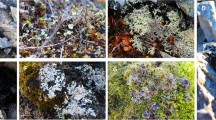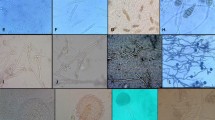Abstract
Fungus growing termites is a unique group of termites that can grow mutualistic fungi from Basidiomycota: Termitomyces inside their nest. This group of termites has an important ecological role as a major decomposer. However, comprehensive study of fungus-growing termites is limited in Thailand and the complex termites-fungus relationship is a challenging issue to study. This research was aimed to identify the species of termites and fungal symbionts using DNA barcoding, to compare the molecular results with morphological identification, and to gain insights into the co-evolutionary relationship by constructing co-cladogenesis analysis from the termites and the fungal symbionts. Four termite species (Macrotermes annandalei, Odontotermes feae, Ancistrotermes pakistanicus and Ancistrotermes sp.) from four Sakaerat and two Chulabhorn colonies were identified based on the BLAST-N of cytochrome oxidase sub-unit I (COI) sequence and morphological identification. The partial COI sequence of O. feae identified in this study is the first record of this species deposited into the NCBI nucleotide database. Molecular identification of the fungi were conducted by using nuclear ribosomal internal transcribed spacer (ITS) region. The results showed that those six termite colonies grew specifically the fungal genus Termitomyces. Three genetic groups of Termitomyces i.e. Group 1, Group 2 (T. cylindricus), and Group 6, were present among the six colonies. Molecular identification was confidently supported by morphological identification of termite samples, at least up to the genus level. High host-symbionts specificity is considerably observed within some clades on paired termite-fungus phylogeny. However, more sampling is needed for the more confident result.




Similar content being viewed by others
Data availability
All data generated and analyzed during this study are included in this published article.
References
Aanen DK (2006) As you reap, so shall you sow: coupling of harvesting and inoculating stabilizes the mutualism between termites and fungi. Biol Lett 2:209–212. https://doi.org/10.1098/rsbl.2005.0424
Aanen DK, Eggleton P (2005) Fungus-growing termites originated in African rain forest. Curr Biol 15:851–855. https://doi.org/10.1016/j.cub.2005.03.043
Aanen DK, Eggleton P, Rouland-lefèvre C et al (2002) The evolution of fungus-growing termites and their mutualistic fungal symbionts. Proc Natl Acad Sci U S A 99:14887–14892. https://doi.org/10.1073/pnas.222313099
Aanen DK, Ros VID, de Fine Licht HH et al (2007) Patterns of interaction specificity of fungus-growing termites and Termitomyces symbionts in South Africa. BMC Evol Biol 7:115. https://doi.org/10.1186/1471-2148-7-115
Ahamad M (1965) Termites (Isoptera) of Thailand. Bull Am Museum Nat Hist 131:1–114
Austin JW, Szalanski AL, Cabrera BJ (2004) A Phylogenetic Analysis of the Subterranean Termite Family Rhinotermitidae (Isoptera) using the mitochondrial cytochrome oxidase (COII) gene. Annu Entomol Soc Am 97:548–555
Batra SWT (1975) Termites (Isoptera) eat and manipulate symbiotic fungi. J Kansas Entomol Soc 48:89–92
Bourguignon T, Lo N, Šobotník J et al (2017) Mitochondrial Phylogenomics resolves the global spread of higher termites, ecosystem engineers of the tropics. Mol Biol Evol 34:msw253. https://doi.org/10.1093/molbev/msw253
Chhotani OB, Bose G (1985) Insecta: Isoptera. Rec Zool Surv India 82:53–60. https://doi.org/10.1017/CBO9781107415324.004
Copren KA, Nelson LJ, Vargo EL, Haverty MI (2005) Phylogenetic analyses of mtDNA sequences corroborate taxonomic designations based on cuticular hydrocarbons in subterranean termites. Mol Phylogenet Evol 35:689–700. https://doi.org/10.1016/j.ympev.2005.03.002
De Fine Licht HH, Andersen A, Aanen DK (2005) Termitomyces sp. associated with the termite Macrotermes natalensis has a heterothallic mating system and multinucleate cells. Mycol Res 109:314–318. https://doi.org/10.1017/S0953756204001844
Dimijian GG (2000) Evolving together: the biology of symbiosis, part 1. Proc (Baylor Univ Med Cent) 13:217–226
Doyle JJ, Doyle J (1987) A rapid DNA isolation procedure for small quantities of fresh leaf tissue. Phytochem Bull 19:11–15
Eggleton P (2011) An introduction to termites: biology, taxonomy and functional morphology. In: Bignell DE, Roisin Y, Lo N (eds) Biology of termites: a modern synthesis. Springer, Berlin, pp 1–26
Fournier A (2013) The story of symbiosis with zooxanthellae, or how they enable their host to thrive in a nutrient poor environment. masters Biosci Rev - Ec Norm Supérieure Lyon 01:1–8
Freeman S, Sharon M, Dori-Bachash M et al (2016) Symbiotic association of three fungal species throughout the life cycle of the ambrosia beetle Euwallacea nr. fornicatus. Symbiosis 68:115–128. https://doi.org/10.1007/s13199-015-0356-9
Gardes M, Bruns TD (1993) ITS primers with enhanced specificity for basidiomycetes - application to the identification of mycorrhizae and rusts. Mol Ecol 2:113–118. https://doi.org/10.1111/j.1365-294X.1993.tb00005.x
Hall T (1999) BioEdit: a user-friendly biological sequence alignment editor and analysis program for windows 95/98/NT. Nucleic Acids Symp Ser 41:95–98
Harnboonsong Y (1986) Fungus growing termites (in Thailand). Kasetsart University
Hebert PDN, Ratnasingham S, DeWaard JR (2003a) Barcoding animal life : cytochrome c oxidase subunit 1 divergences among closely related species. Proc R Soc Lond B 270:S96–S99. https://doi.org/10.1098/rsbl.2003.0025
Hebert PDN, Cywinska A, Ball SL, DeWaard JR (2003b) Biological identifications through DNA barcodes. Proc R Soc B Biol Sci 270:313–321. https://doi.org/10.1098/rspb.2002.2218
Hecker KH, Roux KH (1996) High and low annealing temperatures increase both specificity and yield in touchdown and stepdown PCR. Biotechniques 20:478–485. https://doi.org/10.2144/19962003478
Jannual N, Nipitwattanaphon M, Hasin S (2020) Morphological and molecular characterization of Termitomyces (Lyophyllaceae, Agaricales) in Thailand. Biodiversitas 21:2481–2491. https://doi.org/10.13057/biodiv/d210620
Jouquet P, Boulain N, Gignoux J, Lepage M (2004) Association between subterranean termites and grasses in a west African savanna: spatial pattern analysis shows a significant role for Odontotermes n. pauperans. Appl Soil Ecol 27:99–107. https://doi.org/10.1016/j.apsoil.2004.05.002
Kallehwaraswamy CM, Nagaraju DK, Viraktamath CA (2013) Illustrated identification key to common termite (Isoptera) genera of South India. Biosystematica 7:11–21
Kirtibutr N, Takuya A (1997) Biology and ecology of termites in Thailand. In: International field biology course in Western Pacific and Asia III: Thailand tropical forest. p 134
Konaté S, Le Roux X, Verdier B, Lepage M (2003) Effect of underground fungus-growing termites on carbon dioxide emission at the point- and landscape-scales in an African savanna. Funct Ecol 17:305–314
Krishna K, Grimaldi DA, Krishna V, Engel MS (2013) Treatise on The Isoptera of the world. Bull Am Museum Nat Hist 2:1–2704
Kumar S, Stecher G, Tamura K (2016) MEGA7: Molecular Evolutionary Genetics Analysis Version 7.0 for Bigger Datasets. Mol Biol Evol 33: https://doi.org/10.1093/molbev/msw054
Laine AL (2009) Role of coevolution in generating biological diversity: spatially divergent selection trajectories. J Exp Bot 60:2957–2970. https://doi.org/10.1093/jxb/erp168
Legendre F, Whiting MF, Bordereau C et al (2008) The phylogeny of termites (Dictyoptera: Isoptera) based on mitochondrial and nuclear markers: implications for the evolution of the worker and pseudergate castes, and foraging behaviors. Mol Phylogenet Evol 48:615–627. https://doi.org/10.1016/j.ympev.2008.04.017
Leuthold RH, Badertscher S, Imboden H (1989) The inoculation of newly formed fungus comb withTermitomyces in Macrotermes colonies (Isoptera, Macrotermitinae). Insect Soc 36:328–338. https://doi.org/10.1007/BF02224884
Morimoto K (1973) Termites from Thailand. Bull Gov For Exp Sta 57–80
Nakamura T, Yamada KD, Tomii K, Katoh K (2018) Parallelization of MAFFT for large-scale multiple sequence alignments. Bioinformatics 34:2490–2492. https://doi.org/10.1093/bioinformatics/bty121
Nobre T, Aanen DK (2012) Fungiculture or termite husbandry? The ruminant hypothesis. Insects 3:307–323. https://doi.org/10.3390/insects3010307
Nobre T, Koopmanschap B, Baars JJP et al (2014) The scope for nuclear selection within Termitomyces fungi associated with fungus-growing termites is limited. BMC Evol Biol 14:121. https://doi.org/10.1186/1471-2148-14-121
Otani S, Challinor VL, Kreuzenbeck NB et al (2019) Disease-free monoculture farming by fungus-growing termites. Sci Rep 9:1–10. https://doi.org/10.1038/s41598-019-45364-z
Pegler DN, Vanhaecke M (1994) Termitomyces of Southeast Asia. Kew Bull 49:717–736. https://doi.org/10.2307/4118066
Saha N, Mazumdar PC, Basak J et al (2016) Subterranian termite genus Odontotermes (Blattaria: Isoptera: Termitidae) from Chhattisgarh, India with its annotated checklist and revised key. J Threat Taxa 8:8602–8610. https://doi.org/10.11609/jott.2654.8.3.8602-8610
Sands WA (1956) Some factors affecting the survival of Odontotermes badius. Insect Soc 3:531–536. https://doi.org/10.1007/BF02226456
Savolainen V, Cowan RS, Vogler AP et al (2005) Towards writing the encyclopaedia of life: An introduction to DNA barcoding. Philos Trans R Soc B Biol Sci 360:1805–1811. https://doi.org/10.1098/rstb.2005.1730
Sawhasan P, Worapong J, Vinijsanun T (2011) Morphological and molecular studies of selected Termitomyces species collected from 8 districts of Kanchanaburi province, Thailand. Thai J Agric Sci 44:183–196
Schoch CL, Seifert KA, Huhndorf S et al (2012) Nuclear ribosomal internal transcribed spacer (ITS) region as a universal DNA barcode marker for Fungi. Proc Natl Acad Sci U S A 109:6241–6246. https://doi.org/10.1073/pnas.1117018109
Simon C, Frati F, Beckenbach A et al (1994) Evolution, weighting, and phylogenetic utility of mitochondrial gene sequences and a compilation of conserved polymerase chain reaction primers. Ann Entomol Soc Am 87:651–701. https://doi.org/10.1093/aesa/87.6.651
Sornnuwat Y, Vongkaluang C, Takematsu Y (2004) A systematic key to termites of Thailand. Kasetsart J 38:349–368
Suárez J (2018) The importance of symbiosis in philosophy of biology: an analysis of the current debate on biological individuality and its historical roots. Symbiosis 76:77–96. https://doi.org/10.1007/s13199-018-0556-1
Taprab Y, Ohkuma M, Johjima T et al (2002) Molecular phylogeny of symbiotic basidiomycetes of fungus-growing termites in Thailand and their relationship with the host. Biosci Biotechnol Biochem 66:1159–1163. https://doi.org/10.1271/bbb.66.1159
Vesala R, Niskanen T, Liimatainen K et al (2017) Diversity of fungus-growing termites ( Macrotermes ) and their fungal symbionts (Termitomyces) in the semiarid Tsavo ecosystem, Kenya. Biotropica 49:402–412. https://doi.org/10.1111/btp.12422
Wang B, Geng XZ, Bin Ma L et al (2014) A trophic cascade induced by predatory ants in a fig-fig wasp mutualism. J Anim Ecol 83:1149–1157. https://doi.org/10.1111/1365-2656.12219
Wei T-Z, Tang B, Yao Y-J (2009) Revision of Termitomyces in China. Mycotaxon 108:257–285. https://doi.org/10.5248/108.257
Wetterer JK, Schultz TR, Meier R (1998) Phylogeny of fungus-growing ants (tribe Attini) based on mtDNA sequence and morphology. Mol Phylogenet Evol 9:42–47. https://doi.org/10.1006/mpev.1997.0466
White T, Bruns T, Lee S, et al (1990) Amplification and Direct Sequencing of Fungal Ribosomal RNA Genes for Phylogenetics. In: Innis MA, Gelfand DH, Sninsky JJ, White TJ (eds) PCR Protocols: A Guide to Methods and Applications. Elsevier Science, 1990, pp 315–322
Zaman L, Meyer JR, Devangam S et al (2014) Coevolution drives the emergence of complex traits and promotes evolvability. PLoS Biol 12:e1002023. https://doi.org/10.1371/journal.pbio.1002023
Zook D (2010) Tropical rainforests as dynamic symbiospheres of life. Symbiosis 51:27–36. https://doi.org/10.1007/s13199-010-0071-5
Acknowledgements
The authors convey sincere acknowledgement to the International Program Centre, Faculty of Science, Kasetsart University (KU) in collaboration with Department of Biology, Faculty of Mathematics and Natural Science, IPB University that support this research during Undergraduate Exchange on Research Program, Fall Semester 2017.
Funding
This research was supported by Biodiversity-Based Economy Development Office (BEDO) – National Research Council of Thailand (NRCT) 3/2560.
Author information
Authors and Affiliations
Contributions
Not applicable.
Corresponding author
Ethics declarations
Competing interests
The authors declare that they have no competing interests.
Ethics approval
Not applicable.
Consent to participate
Not applicable.
Consent for publication
Not applicable.
Code availability
Not applicable.
Additional information
Publisher’s note
Springer Nature remains neutral with regard to jurisdictional claims in published maps and institutional affiliations.
Supplementary Information
Online Resource 1
The best BLAST-N result of ITS-clone sequences from termite guts (PDF 168 kb)
Online Resource 2
The best BLAST-N result of ITS-clone sequences from nodules (PDF 293 kb)
Online Resource 3
The best BLAST-N result of ITS-clone sequences from mushroom (PDF 417 kb)
Online Resource 4
Termite phylogenetic tree for supporting BLAST results. The tree was generated based on partial COI gene by using Maximum Likelihood method with branch scores represent 1000x boostraps. (PDF 518 kb)
Online Resource 5
Termitomyces phylogenetic tree for supporting BLAST results. The tree was generated based on ITS sequences (257 bp) by using Maximum Likelihood method with branch scores represent 1000x boostraps. (PDF 322 kb)
Online Resource 6
List of published COI termite sequences used in phylogenetic tree for supporting termite BLAST results (PDF 140 kb)
Online Resource 7
List of published ITS region sequences used in phylogenetic tree for suppoting fungal BLAST results (PDF 271 kb)
Rights and permissions
About this article
Cite this article
Shaleh, I., Jannual, N., Hasin, S. et al. Identification of fungus-growing termites and mutualistic Termitomyces from two provinces in Thailand. Int J Trop Insect Sci 41, 1555–1566 (2021). https://doi.org/10.1007/s42690-020-00355-w
Received:
Accepted:
Published:
Issue Date:
DOI: https://doi.org/10.1007/s42690-020-00355-w




